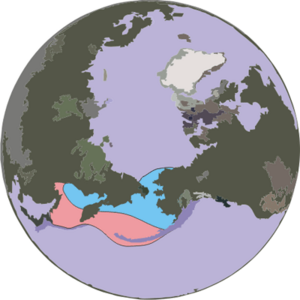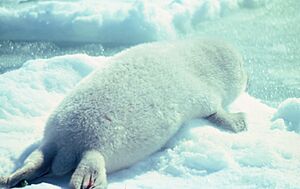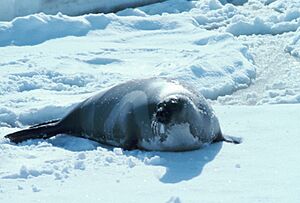Ribbon seal facts for kids
Quick facts for kids Ribbon seal |
|
|---|---|
 |
|
| Conservation status | |
| Scientific classification | |
| Genus: |
Histriophoca
|
| Species: |
fasciata
|
 |
|
| Ribbon seal range (blue – summer, pink – maximal) | |
The ribbon seal (Histriophoca fasciata) is a medium-sized seal. It belongs to the true seal family, called Phocidae. These seals live in icy areas. You can find them in the Arctic and Subarctic parts of the North Pacific Ocean. They are often seen in the Bering Sea and Sea of Okhotsk. Ribbon seals are easy to spot because of their unique look. They have two wide white stripes and two white circles on their dark brown or black fur.
This seal is the only living species in its group, called Histriophoca. Scientists once found a possible fossil species, H. alekseevi, in Moldova. This fossil was from a time called the Miocene period.
Contents
Description
Adult ribbon seals have black skin with four white marks. One white stripe goes around their neck. Another stripe goes around their tail. There is also a white circle on each side of their body. These circles enclose their front flippers. The white marks stand out a lot on males. On females, the color difference is often not as clear.
Newborn ribbon seal pups have soft, white fur. This fur is called natal fur or lanugo. After they shed this fur, their color changes. Their backs become blue-grey, and their undersides turn silvery. Over three years, their fur changes color after each molt. Some parts get darker, and others get brighter. The striped pattern only fully appears when they are about four years old.
The ribbon seal has a short nose. It has wide, deep nostrils and large, round eyes that face forward. Like other true seals, it has large ear bones inside its head. It does not have a bony ridge on top of its skull. Ribbon seals have curved, widely spaced teeth. Their canine teeth are smaller than those of other seals.
Ribbon seals have a large air sac connected to their windpipe. This sac extends over their ribs on the right side. It is bigger in males than in females. Scientists think males use it to make sounds underwater. These sounds might help them attract a mate. Unlike other seals, the ribbon seal's lungs are not divided into smaller parts. A ribbon seal can grow to about 1.6 meters (5.2 feet) long. They can weigh around 95 kilograms (209 pounds). Males are usually larger than females.
The main animals that hunt ribbon seals are great white sharks and orcas (killer whales).
Differences Between Males and Females
Male ribbon seals are usually bigger than females. You can especially see this in their skulls. The openings for the nostrils are much larger in males. Scientists believe that larger males have a better chance to mate with many females. This helps them pass on their genes. They also tend to win fights with other males over females.
Habitat
Ribbon seals live in the Arctic parts of the Pacific Ocean. During winter and spring, they climb out onto pack ice. They use this ice to breed, shed their fur, and give birth. At this time, they are found at the edge of the ice. This includes the Bering Sea and Okhotsk Sea.
During summer, the ice melts and moves away. Ribbon seals then live in open water. Some seals move south as the ice recedes. We do not know much about what they do during this time. This is because they are far from land and human observation. Ribbon seals almost never come to land.
Sometimes, ribbon seals have been seen far south. They were found in places like Squamish, British Columbia, and Long Beach, Washington. One was even seen further south in Morro Bay, California. These seals seemed healthy. There was no sign that they were sick.
Behavior
Ribbon seals are not often seen out on the ice and snow. They have a special way of moving on the ice. They wiggle their bodies like a snake. They grip the ice with their claws. Then, they use their flippers to pull themselves across the surface. This way of moving does not work well on other surfaces. This is likely because their fur creates too much friction.
When on the ice, ribbon seals do not seem to care much about what is around them. People in boats have gotten very close to these seals before they move. Mothers have been seen leaving their pups alone for long periods. This suggests that land predators, like bears or humans, do not hunt them much. When these seals get caught in nets, they sometimes pretend to be dead.
Diet
Ribbon seals mostly eat animals that live in the open ocean. Their diet includes fish like pollock, eelpout, and Arctic cod. They also eat cephalopods, such as squid and octopus. Young seals also eat small crustaceans.
Ribbon seals dive up to 200 meters (656 feet) to find food. They are usually alone and do not form large groups. Ribbon seals in the Bering Sea mainly eat pollock, eelpout, and arctic cod. Adult seals have weak and smooth canine teeth. This is because their food does not need to be torn apart.
Reproduction
Ribbon seals have a mating system where one male mates with many females. This is called polygyny. They mate and give birth on pack ice. This is sea ice that is not connected to land. Males use sounds to protect their breeding areas. They also use sounds to attract mates.
Males can start mating when they are three to six years old. Females can start mating between two and five years old. They breed once a year. This usually happens in late May to June. This time matches when the sea ice starts to melt in spring.
After mating, the embryo does not attach right away. It has a delay of about two to four months. This is called delayed implantation. This delay allows the female to give birth when there is the most sea ice. Pregnant females are pregnant for about ten to eleven months. They give birth to one pup.
Females care for their pup on the pack ice for about four to six weeks. The milk they give their pup is very rich in proteins and fats. This helps the pup grow very fast. While feeding her pup, a female ribbon seal does not hunt for food. She uses the fat stored in her body. After the pup stops drinking milk, the female teaches it how to dive and find its own food.
Seal pups are born with a white fur coat called lanugo. They shed this coat about a month after birth. These pups do not go into the water until their lanugo is completely gone. This is because their layer of blubber, which protects them from the cold ocean, is not fully developed yet. Young ribbon seals were once hunted a lot for their soft, thick fur. This caused their population to drop.
Protection
Young ribbon seals look like young harp seals. Like harp seals, they were hunted for their fur. Ribbon seals do not form large groups. This made them harder to catch than harp seals. The Soviet Union limited the hunting of ribbon seals in 1969. Since then, their population has grown back. Today, there are about 250,000 ribbon seals.
In March 2008, the US government agreed to study Alaska's ribbon seal population. They thought about adding it to the endangered species list. However, in December 2008, the US government decided that sea ice, which is vital for the seals, would not be threatened by global warming. So, they decided not to list the species as endangered. Instead, it became a U.S. National Marine Fisheries Service Species of Concern. This means the government has some worries about the species. But there is not enough information to list them under the US Endangered Species Act.
In the summer of 2009, the Center for Biological Diversity filed a lawsuit. They wanted the decision changed. On July 10, 2013, the National Marine Fisheries Service looked at the species again. They found that listing the ribbon seal as endangered was still not needed.





